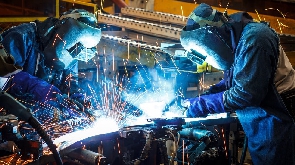The industrial sector delivered a strong performance in the second quarter (Q2) of 2024 , recording a year-on-year (YoY) growth of 8.2 percent according to the latest Index of Industrial Production (IIP) released by Ghana Statistical Service (GSS).
The growth was largely driven by robust expansion in the mining and quarrying and manufacturing sub-sectors, which posted increases of 8.2 percent and 8.3 percent respectively.
This marked improvement in industrial production, analysts say, is reflective of the economy’s resurgence, especially within its key industrial segments despite persistent challenges in the energy sector.
Mining, quarrying lead growth
The mining and quarrying sector remains a cornerstone of the country’s industrial expansion, accounting for 53.26 percent of industrial output.
On a YoY basis, the sub-sector grew by 8.2 percent. It had an index value of 88.9 in Q2 of 2023. This rose to 97.1 in Q2 of 2024.
The increase was driven primarily by the mining of metal ores – which surged by 12.1 percent YoY – and the other mining and quarrying segment, which saw a substantial 24.8 percent growth in production.
It is expected that the mining sector will continue being a major contributor to the industrial economy, as sustained global demand for minerals such as gold and manganese are projected to remain strong and drive further growth.
The production of crude petroleum and natural gas saw more modest growth, increasing by 4.7 percent over the same period last year despite a 4.4 percent decline quarter-on-quarter, reflecting the inherent volatility in global energy markets.
Manufacturing rebounds
Manufacturing also played a significant role in the sector’s overall growth, expanding by 8.3 percent YoY. Notably, the basic metals sub-sector recorded the largest quarterly growth at 18.5 percent compared to Q1 2024, while the manufacture of transport equipment grew by 20.9 percent over the year.
However, performance within the manufacturing sector was mixed. Manufacturing food products recorded a significant quarterly decline of 12.3 percent, largely due to supply chain disruptions and input cost pressures which have affected production.
Energy weakens
In contrast to positive performances in mining and manufacturing, the electricity and gas sub-sector recorded a decline of 1.4 percent over the year.
Quarter-on-quarter, the sub-sector’s production levels dropped by 4.3 percent – reflecting ongoing challenges in the supply and distribution of electricity and gas across the country. The shortfall in energy production has raised concerns about its potential to slow down industrial activity during the coming quarters.
Water-supply, waste management see modest growth
The water-supply, sewage, and waste management sub-sector posted modest growth of 1.2 percent on an annual basis.
Quarter-on-quarter, the sector’s output increased by 2.8 percent, indicating marginal improvements in production volumes – although waste collection and disposal activities experienced a 4.8 percent quarterly decline.
Outlook for industrial growth
While the energy sector’s struggles present challenges, the overall outlook for Ghana’s industrial sector remains optimistic; bolstered by the strong performances in mining and manufacturing.
Analysts suggest that sustained global demand for natural resources, coupled with improved domestic production capacity, could support continued growth in second-half 2024.
Business News of Friday, 18 October 2024
Source: thebftonline.com

















